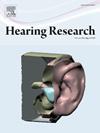关于鸡尾酒会的问题:孩子们会在8千赫以上的频率上使用他们敏锐的听觉吗?
IF 2.5
2区 医学
Q1 AUDIOLOGY & SPEECH-LANGUAGE PATHOLOGY
引用次数: 0
摘要
在具有挑战性的听力环境中分离语音流的能力,通常被称为“鸡尾酒会效应”,对儿童学习有效沟通至关重要,尤其是在嘈杂的教室环境中。这一发育过程受到听觉灵敏度、认知能力和声音线索等因素的影响,但与8千赫以上频率的听力有关的研究尚未得到彻底的研究,儿童对8千赫以上频率的听力比成人更为敏感。这代表了一个关键的差距,因为新兴的研究揭示了过滤掉这些信息的重大有害影响。本研究探讨了扩展高频(EHF)敏感性在4-14岁正常听力儿童言语流分离中的功能作用。为了减少认知负荷,研究人员在四种分离提示条件下对语音任务的表现进行了测量:基线提示(同址、说话者性别匹配)、说话者性别提示(说话者性别不匹配)、空间提示(目标和面具在空间上分离)和组合提示(说话者性别提示和空间提示)。结果表明,EHF敏感性在基线和说话者性别线索条件下对srt的改善有独特的贡献,强调了它在说话者特定线索对流分离至关重要的情况下的重要性。然而,在空间或组合线索条件下,EHF敏感性不影响srt,也不显著影响任何条件下的掩蔽释放。这些发现表明,虽然EHF敏感性在分离语音流方面起着关键作用,但当有明显的空间线索时,它的作用可能不那么突出。这项研究强调了在复杂的听力环境中,当分离竞争性言语时,儿童对利用说话者特定线索的EHF敏感性的重要性。本文章由计算机程序翻译,如有差异,请以英文原文为准。
On the cocktail-party problem: Do children use their exquisite hearing at frequencies above 8 kHz?
The ability to segregate speech streams in challenging listening environments, often referred to as the "cocktail party effect," is critical for children learning effective communication, especially in noisy classroom settings. This developmental process, influenced by factors such as hearing sensitivity, cognitive abilities, and acoustic cues, has not been thoroughly examined in relation to hearing at frequencies above 8 kHz, to which children are exquisitely more sensitive than adults. This represents a critical gap, as emerging studies reveal the significant detrimental effects of filtering out this information. The present study investigated the functional role of extended high-frequency (EHF) sensitivity in speech stream segregation in normal-hearing children aged 4–14 years. Using digit triplets to reduce cognitive load, performance on speech tasks were measured across four segregation cue conditions: baseline (co-located, talker-sex matched), talker-sex cue (talker-sex mismatched), spatial cue (spatially separated target and maskers), and combined (talker-sex cue and spatial cue). Results demonstrate that EHF sensitivity uniquely contributes to improved SRTs in baseline and talker-sex cue conditions, underscoring its importance in situations where talker-specific cues are crucial for stream segregation. However, EHF sensitivity did not influence SRTs in the spatial or combined cue conditions, nor did it significantly affect release from masking in any conditions. These findings suggest that while EHF sensitivity plays a key role in segregating speech streams, its contribution may be less prominent when salient spatial cues are available. This research highlights the importance of EHF sensitivity in children for utilization of talker-specific cues when segregating competing speech in complex listening environments.
求助全文
通过发布文献求助,成功后即可免费获取论文全文。
去求助
来源期刊

Hearing Research
医学-耳鼻喉科学
CiteScore
5.30
自引率
14.30%
发文量
163
审稿时长
75 days
期刊介绍:
The aim of the journal is to provide a forum for papers concerned with basic peripheral and central auditory mechanisms. Emphasis is on experimental and clinical studies, but theoretical and methodological papers will also be considered. The journal publishes original research papers, review and mini- review articles, rapid communications, method/protocol and perspective articles.
Papers submitted should deal with auditory anatomy, physiology, psychophysics, imaging, modeling and behavioural studies in animals and humans, as well as hearing aids and cochlear implants. Papers dealing with the vestibular system are also considered for publication. Papers on comparative aspects of hearing and on effects of drugs and environmental contaminants on hearing function will also be considered. Clinical papers will be accepted when they contribute to the understanding of normal and pathological hearing functions.
 求助内容:
求助内容: 应助结果提醒方式:
应助结果提醒方式:


